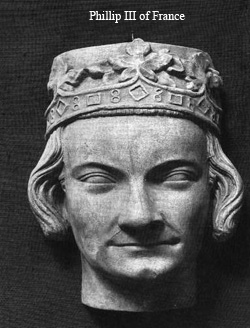Unable to
attack his  Iberian enemies in Italy,
Charles
of Anjou continued work on a plan he had devised to rid himself of
Peter III.
The idea was to have a crusade called
against Peter and to invade Aragon from France. His plan had the
support of Pope Martin IV who excommunicated Peter in February 1282 for his invasion of
Sicily, and at the urging of Charles, on March 21, 1283,
declared all of Peter's holdings and his crown forfeit.
The entire plan revolved around the Crown of Aragon being given to
Charles's nephew, Philip III of France, over whom Charles had a great
deal of influence. If the crusade were successful, not only would Charles
regain Sicily, but also he would remove his only rival for control of the
western Mediterranean. The defeats at Malta and Naples had set back these
plans, but Charles had the resources to make good his material losses. The
crusade against Peter was simply delayed, not cancelled.
Iberian enemies in Italy,
Charles
of Anjou continued work on a plan he had devised to rid himself of
Peter III.
The idea was to have a crusade called
against Peter and to invade Aragon from France. His plan had the
support of Pope Martin IV who excommunicated Peter in February 1282 for his invasion of
Sicily, and at the urging of Charles, on March 21, 1283,
declared all of Peter's holdings and his crown forfeit.
The entire plan revolved around the Crown of Aragon being given to
Charles's nephew, Philip III of France, over whom Charles had a great
deal of influence. If the crusade were successful, not only would Charles
regain Sicily, but also he would remove his only rival for control of the
western Mediterranean. The defeats at Malta and Naples had set back these
plans, but Charles had the resources to make good his material losses. The
crusade against Peter was simply delayed, not cancelled.
While the campaign against Calabria and Sicily had resulted in another defeat, Charles had lost relatively few ships and his army was relatively intact despite the desertions. By the end of 1284, he was preparing a crusade against Aragon to be launched during the spring of 1285. He would never see the fruition of his efforts or the defeat of his archrival Peter of Aragon. While traveling through the eastern section of Apulia he became ill and died on January 7th, 1285, in the town of Foggia. In his will he left his kingdom to his imprisoned son Charles of Salerno, but if that son should die in prison then the kingdom would go to his younger son Charles Martel. Ironically, Charles died having seen virtually all of his careful plans and machinations unravel, mainly due to the efforts of Roger of Lauria. His planned invasion of the Byzantine Empire had collapsed, he had lost a large portion of the Kingdom of Sicily, Naples was virtually blockaded, and the rest of the kingdom was under threat of attack. His death marked the beginning of a fateful year that would change the course of the conflict.


